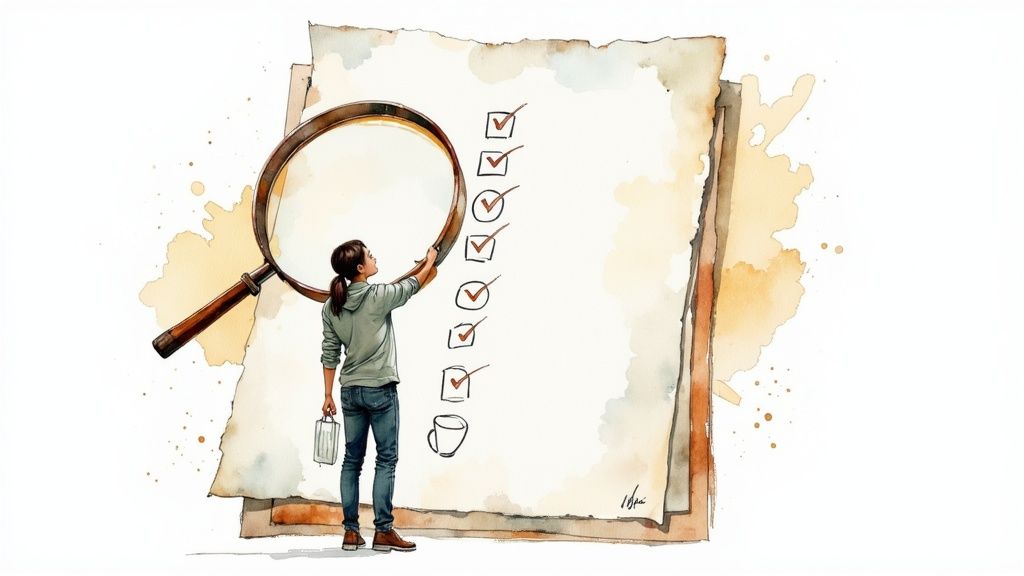How to Manage Client Expectations for Project Success
Max
Successfully managing client expectations is a fluid process built on a foundation of clear communication, detailed documentation, and a true partnership. It’s far less about enforcing rigid rules and more about adapting to the project’s needs while keeping everyone perfectly aligned from kickoff to completion.
This approach is your best defense against scope creep. More importantly, it builds genuine trust and fosters the kind of long-term client relationships that sustain a business.
Why Managing Client Expectations Is Your Most Critical Skill

Let’s be real—misaligned expectations can torpedo a project faster than any technical glitch. When your vision of success is miles apart from your client’s, you’re headed for a world of frustration, endless revisions, and a relationship that’s damaged goods.
Learning how to set and manage client expectations isn’t just a nice-to-have soft skill; it’s the bedrock of project profitability and sustainability.
This becomes even more crucial in remote work, where you can’t just pop over to someone’s desk for a quick clarification. The principles for guiding remote teams effectively have a lot in common with client management—both hinge on structured communication and shared goals. You can read more about that overlap in our guide on how to manage remote teams.
The Four Pillars of Expectation Management
To keep things straightforward, I’ve found it helps to think about this process as resting on four key pillars. These are the core principles that form the foundation of every successful client engagement I’ve ever had. They provide a simple framework you can always come back to.
| Pillar | Core Principle | Key Action |
|---|---|---|
| Clarity | Ambiguity is the enemy. Ensure every detail is understood by both parties. | Create detailed scopes of work (SOWs), define key terms, and ask clarifying questions. |
| Communication | Keep information flowing consistently and proactively. | Establish regular check-ins, provide status updates, and never hide bad news. |
| Consistency | Deliver a predictable and reliable experience from start to finish. | Use repeatable processes, standardized templates, and honor all commitments. |
| Collaboration | Treat the client as a partner, not just a customer. | Involve them in key decisions, listen to their feedback, and co-create solutions. |
Mastering these four areas will fundamentally change the way you work with clients, turning potentially tense projects into smooth, collaborative successes.
The Rising Bar for Client Satisfaction
Clients today are savvier and have higher standards than ever before. This isn’t a bad thing, but it does demand a more proactive and strategic approach from us.
Recent customer experience reports confirm this loud and clear. One study found that 68% of CX experts believe customer expectations are rising, and 43% feel customers are more impatient. This data just reinforces the absolute need for crystal-clear alignment from day one.
The heart of great client management isn’t about always saying “yes.” It’s about creating a shared reality where both parties understand the goals, the process, and the potential roadblocks long before they become problems.
When you get this right, the benefits are huge and immediate:
- Reduced Scope Creep: Clearly defined boundaries keep projects from spiraling out of control with “just one more thing” requests.
- Increased Trust: Honest, proactive communication builds a rock-solid foundation of trust that can weather any storm.
- Higher Client Retention: Happy clients who feel heard and respected don’t just stick around; they become repeat business.
- Stronger Referrals: A fantastic experience transforms clients into your most powerful and credible brand advocates.
Uncovering Hidden Goals in the Discovery Phase

The discovery phase is where projects are made or broken, but it’s the part everyone seems to want to rush. Here’s a hard-earned lesson: a project’s success almost never depends on what the client asks for initially. It hinges on what they actually need.
Your job is to be a detective. You have to dig beneath the surface-level requests to get to the real business drivers.
Simply asking, “So, what are the deliverables?” is a recipe for disaster. That question gets you a checklist, not a strategy. You need to flip the script and turn that first meeting from a simple requirements-gathering session into a strategic workshop where you build a shared vision.
Asking Questions That Reveal True Intent
To get past the to-do list, you have to ask questions that uncover motivation, context, and what success truly looks like for them. You’re hunting for the “why” behind the “what.”
Here are a few of my go-to, open-ended questions to get the conversation flowing:
- “Let’s imagine it’s six months after this project is finished. What happened that makes you feel it was a massive success?” This question forces them to visualize the ideal outcome and reveals what genuinely matters.
- “What would make this project a personal win for you and your team?” This is how you uncover the individual motivations and internal pressures that are always steering the ship, whether they’re stated or not.
- “What’s the one thing we absolutely cannot get wrong?” This cuts through the noise and immediately helps you prioritize the most critical factor for success.
Questions like these completely change the dynamic. Suddenly, you’re not just an order-taker; you’re a strategic partner who’s just as invested in their success as they are.
A project brief might say, “We need a new website.” But after a few good questions, you discover the hidden goal is, “We need to slash our customer support calls by 25%.” Uncovering that metric changes everything about how you approach the project.
From Vague Goals to Concrete Success
Once you’ve dug up these deeper goals, you have to make them real. Ambiguous objectives like “increase brand awareness” or “improve user engagement” are impossible to measure and almost always lead to disappointment down the line. It’s your job to translate that fuzziness into specific, measurable outcomes.
Let’s say a client wants to “improve their online presence.” You need to work with them to pin down exactly what that means.
- Vague Goal: Improve online presence.
- Specific Metric: Increase organic search traffic by 20% in the next quarter.
- Specific Metric: Achieve a top-three ranking for five key commercial keywords.
- Specific Metric: Generate 50 qualified leads per month through the contact form.
After you’ve uncovered the goals, defining the precise parameters for success is critical. For a really tight process, I recommend exploring how to write clear Acceptance Criteria for User Stories. It’s a fantastic way to make sure everyone agrees on what “done” actually looks like.
This whole process relies on your ability to listen—truly listen. Sometimes, that means asking for clarification two or three times. Our guide on how to ask for feedback at work has some great tips on active listening that are just as valuable in client conversations. This ensures you’re not building the project on a foundation of assumptions, but on solid, shared understanding.
Creating Your Single Source Of Truth

We’ve all nodded along in a video call, only to find that everyone remembers the details differently days later. Verbal promises evaporate — you need something you can point to without a second thought.
That’s where your single source of truth comes in. Usually a Statement of Work (SOW) or project agreement, it captures every goal, deadline, and deliverable in clear, unambiguous language.
This living document isn’t just about covering your back. It forges a shared understanding, cuts through confusion and ensures new stakeholders hit the ground running.
Building Your Project Constitution
A powerful SOW is more than a task list. Think of it as the project’s rulebook — detailed enough that anyone unfamiliar with the work can pick it up and know exactly what’s happening, who does what, and how you’ll measure success.
- Key Milestones and Timelines: Break the project into phases, each with its own deadline.
- Specific Deliverables: Spell out exactly what you’ll produce (wireframes, code, reports) and when.
- Communication Protocols: Set the rhythm: weekly email digests, bi-weekly strategy calls, or daily stand-ups.
- Feedback and Revision Rounds: Define how many review cycles are included to keep scope creep at bay.
When everyone refers to the same document, “who said what” disputes vanish — you simply revisit the agreed plan.
Defining What Is Out Of Scope
Clarity goes both ways. Alongside what’s in scope, spell out what’s not included. These exclusions become your first line of defense against budget bloat and timeline overruns.
For a website redesign, an “Out of Scope” section might look like this:
- Copywriting and Content Creation: The client provides all website copy.
- Third-Party Plugin Costs: Premium plugins are on the client’s tab.
- Ongoing SEO Services: Includes on-page SEO at launch only, not monthly maintenance.
- Photography or Videography: All visual assets must come from the client.
Laying out boundaries from day one shows you respect the client’s budget and schedule. In fact, research shows 79% of customers make initial purchase decisions based on how well a brand understands them. Discover more in this global CX study.
Lastly, centralize your SOW in a platform everyone uses. A shared workspace stops wandering email threads and lost attachments. Check out our guide on remote collaboration tools to find the right fit.
Building Trust with Proactive Communication

Nothing sets the tone for a transparent relationship quite like consistent, proactive updates. It’s the difference between a client feeling in the loop versus feeling like they have to chase you for information.
A simple weekly check-in can work wonders. This isn’t just about listing tasks you checked off; it’s about connecting your work directly to their goals. A good report should always cover progress, flag potential roadblocks, and outline what’s coming next. This simple framework shifts the conversation from “what we did” to “how we’re delivering on what we promised.”
A solid weekly update usually includes:
- Progress Against Goals: Show them which milestones you’ve hit and how that directly contributes to the outcomes they care about.
- Upcoming Hurdles: Be upfront about potential blockers. More importantly, show them you’re already thinking ahead with mitigation plans.
- Budget Overview: A quick comparison of actual spend versus the forecast is crucial. No one likes billing surprises.
Of course, even with the best-laid plans, things go wrong.
When you hit a snag, addressing it directly—along with a proposed solution—shows real ownership. You control the narrative and maintain your credibility. For instance, if a feature launch is going to be delayed, don’t wait for the client to notice. Get ahead of it. Outline the impact, present a revised timeline, and give them options, like reallocating resources to another priority or adjusting the release scope.
Crafting Reports That Build Confidence
The best reports offer insights, not just a data dump. I always add a bit of commentary to interpret the numbers and connect them back to the project’s big picture. This shows you’re not just executing tasks; you’re a strategic partner.
Bad news framed with a fix turns setbacks into credibility points.
A quick, informal check-in can also be powerful. For high-stakes projects, a brief daily Slack update might be appropriate, while a more detailed report can be reserved for the end of the week.
Getting this right is a huge part of the overall client experience. It’s no surprise the global CX management market was valued at USD 12.04 billion and is expected to hit USD 32.87 billion by 2030. It’s a massive area of focus for businesses everywhere.
These proactive updates create a rhythm the client learns to rely on. To dig deeper into this, check out our guide on Building Trust in Virtual Teams.
Over time, this consistency becomes your signature. Clients stop wondering what’s going on and start trusting that you have everything under control.
Framing Tough Conversations
Bad news is inevitable. How you deliver it, though, can either damage a relationship or make it stronger. Before you even think about picking up the phone or writing that email, get your facts straight.
Map out the issue, its impact, and your proposed next steps.
- Clearly define the scope of the problem.
- Quantify how it affects milestones, the budget, or other resources.
- Propose at least two options—maybe a short-term workaround and a more permanent fix.
Then, bring the client into the conversation. Asking for their input reinforces that you’re a team and you’re solving this together. This simple shift turns a potentially tense situation from “whose fault is this?” to “how do we move forward?”
I remember one remote launch where a critical API integration was delayed, threatening a key feature. We immediately explained the bottleneck, shared a temporary patch we could deploy, and outlined a plan to accelerate testing once the permanent fix was ready. That transparency kept the client in the loop and turned a potential crisis into a moment that actually strengthened their trust in us.
Maintaining Your Communication Rhythm
A predictable schedule is your best friend. It reduces client anxiety because they know when they’ll hear from you, and it shows you respect their time.
You’ll want to balance detailed reports with quick, informal check-ins. The right mix often depends on the project’s phase.
- Start of the week: A summary email covering the top three highlights and priorities.
- Mid-week: Biweekly calls for deeper dives and goal realignment.
- As needed: Keep some time open for urgent discussions or approvals.
When you’re consistently transparent, you cultivate confidence. This isn’t just about sending updates—it’s about locking in aligned expectations and building the kind of trust that makes for truly great, long-lasting client relationships.
How To Navigate Scope Creep And Project Changes
Projects rarely unfold exactly as planned. A new client insight pops up, or the market shifts overnight. While change is inevitable, scope creep—those tiny, undocumented additions that snowball—definitely isn’t.
Your response to these shifts shapes your reputation. You can either react to every whim, or you can step up as a trusted guide who helps clients navigate adjustments. The latter approach fosters genuine respect and stronger partnerships.
The Immediate Impact Assessment
When a fresh request lands in your inbox, don’t rush to a verdict. Pause, gather your thoughts, and map out the consequences. A clear change management routine always starts with an honest impact review.
Ask yourself:
- Timeline: Will this tweak push back our key milestones or final delivery date?
- Budget: What’s the true cost in team hours or new tool subscriptions?
- Resources: Could this pull critical team members away from other essential tasks?
This simple check turns subjective opinions into data-driven insights. You’ll walk into any client call with fact-based trade-offs, not gut reactions.
The best response to scope changes goes beyond yes or no. It’s “Yes, and here’s what that means for our timeline and budget.” That shifts the focus to shared decision-making.
Communicating Change With Confidence
Armed with your analysis, it’s time for a transparent, actionable conversation. Present the impact, then offer realistic paths forward. This turns potential friction into an opportunity for collaboration.
Consider a scenario where a client requests a complex user dashboard midway through development. Rather than absorbing unexpected work, present two structured options:
Option 1: The “Yes, And…” Approach
“I love where you’re headed with a user dashboard. To build it right, we’re looking at roughly 40 hours of dev work. That would move our launch out by two weeks. We can capture this in a change order if you’d like to move forward.”Option 2: The “No, But…” Approach
“That dashboard idea has real potential. Given our current launch timeline, though, adding it now introduces risk. How about we plan it as Phase 2? We stay on track today and immediately scope the dashboard as our next priority.”
When these discussions come up, frameworks like effective priority management systems are a lifesaver. They help everyone visualize priorities and decide where resources should land.
This kind of structured approach is also essential for effective remote workforce management, where clear documentation is your best defense against surprises.
A formal change request process is more than bureaucracy. It’s your safeguard—documenting, approving, and tracking every tweak. That way, the project sails on both schedule and budget, no matter what curveballs come your way.
Answering Your Toughest Client Questions
Even with the most airtight plan, tricky situations are just part of the job. The real test isn’t avoiding tough questions—it’s knowing how to handle them with a cool head. It’s less about having the perfect answer on standby and more about having a solid framework to guide the conversation.
Think of it as preparing for the “what ifs.” This prep work can turn a potential crisis into a chance to show your expertise and actually strengthen the client’s trust in you.
“Why Is This Taking So Long?”
When a client asks this, what they’re really worried about is progress and whether they’re getting value for their money. The worst thing you can do is get defensive. Instead, lead with transparency and tie everything back to the plan you both agreed on.
First, acknowledge their frustration. A simple, “I understand why you’re asking about the timeline” goes a long way. Then, calmly walk them through the progress that’s been made, pulling up your project’s single source of truth—be it the SOW, project plan, or your Asana board. Point to specific complexities or dependencies that have popped up and affected the timeline.
Finally, show them the updated path forward. This isn’t about making excuses; it’s about demonstrating that you’re in control and focused on the solution. It’s a moment to remind them that quality work sometimes just takes time.
“Can We Just Add This One Small Thing?”
Ah, the classic opening line for scope creep. Your response here needs to be a delicate balance of firm and collaborative. The goal is to pivot from a simple “yes” or “no” into a conversation about impact and trade-offs.
Frame your answer around the project’s overall health. Try something like, “That’s a great idea. Let’s take a look at how that would fit into our current priorities and timeline.” This simple phrase opens the door to a structured discussion instead of an immediate commitment.
From there, you can lay out a few clear options:
- Re-prioritize: Offer to swap the new request for a lower-priority task already in the scope.
- Phase Two: Suggest adding it to a “parking lot” or list of post-launch enhancements.
- Change Order: Propose formally scoping the new work with its own timeline and budget.
Responding with a process protects the project’s integrity. It shows you’re a strategic partner who thinks things through, not just an order-taker.
“I’m Not Happy with the Results.”
This one can sting, but it’s a conversation you need to have. When a client expresses disappointment, your first job is just to listen. Don’t interrupt. Let them get everything out on the table so you can fully understand their perspective.
Once you’ve heard them out, bring the conversation back to solid ground with data and the metrics you both agreed on. Pull up the goals defined during your discovery phase. More often than not, disappointment comes from a slight misalignment on what success actually looks like. For instance, if they’re unhappy with lead volume but you’ve hit the keyword ranking goals you set, you can gently guide the conversation back to the original strategy.
But what if you genuinely missed the mark? Own it. Acknowledge the shortfall, explain what you learned from it, and present a clear, actionable plan to get things back on track. Taking accountability builds way more trust in the long run than making excuses ever will.
At Remote First Jobs, we know that clear communication and aligned expectations are the bedrock of any successful remote engagement. Whether you’re a company hiring top-tier talent or a professional looking for your next big opportunity, our platform is built to connect the right people. Find your next great remote role or candidate at Remote First Jobs.


